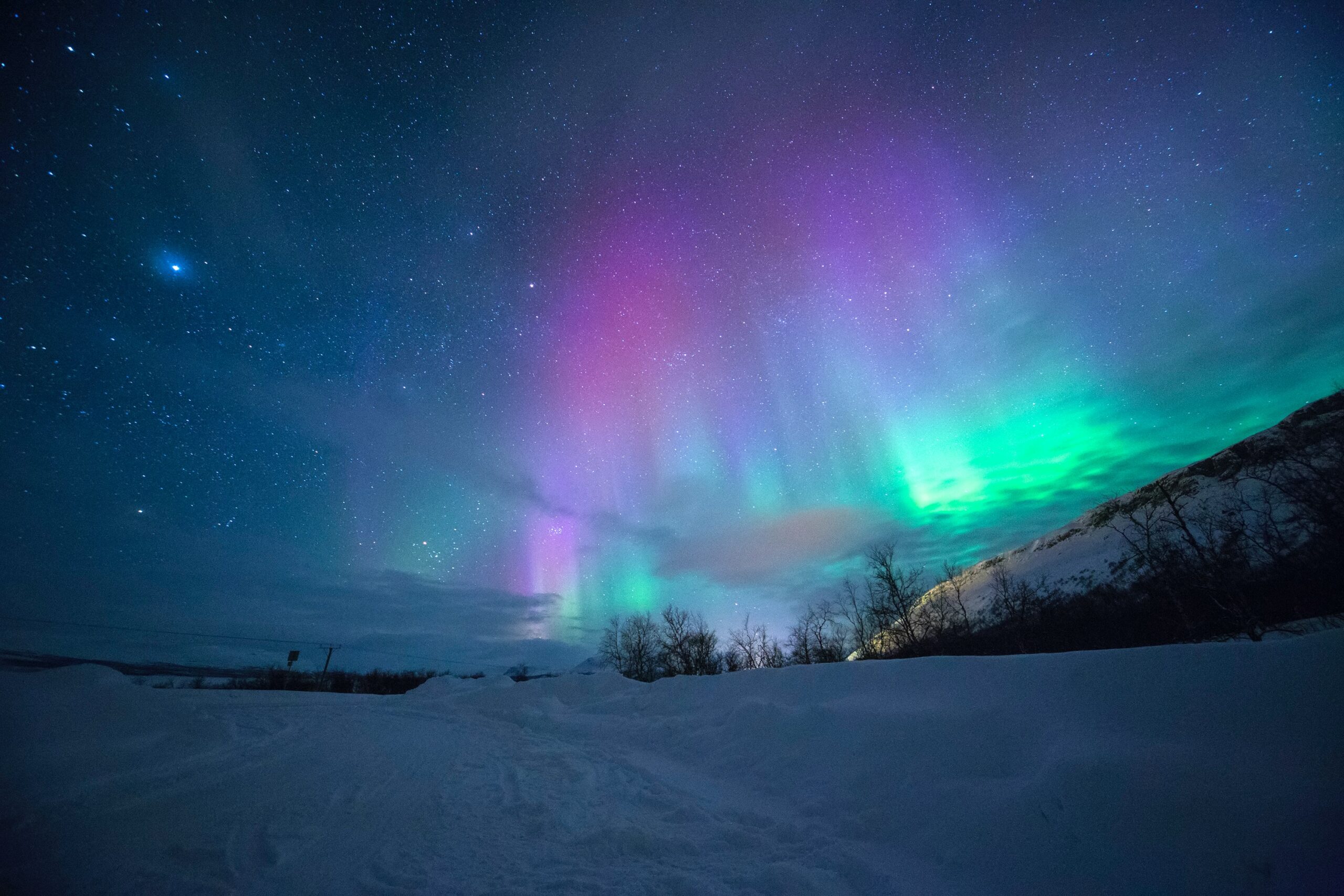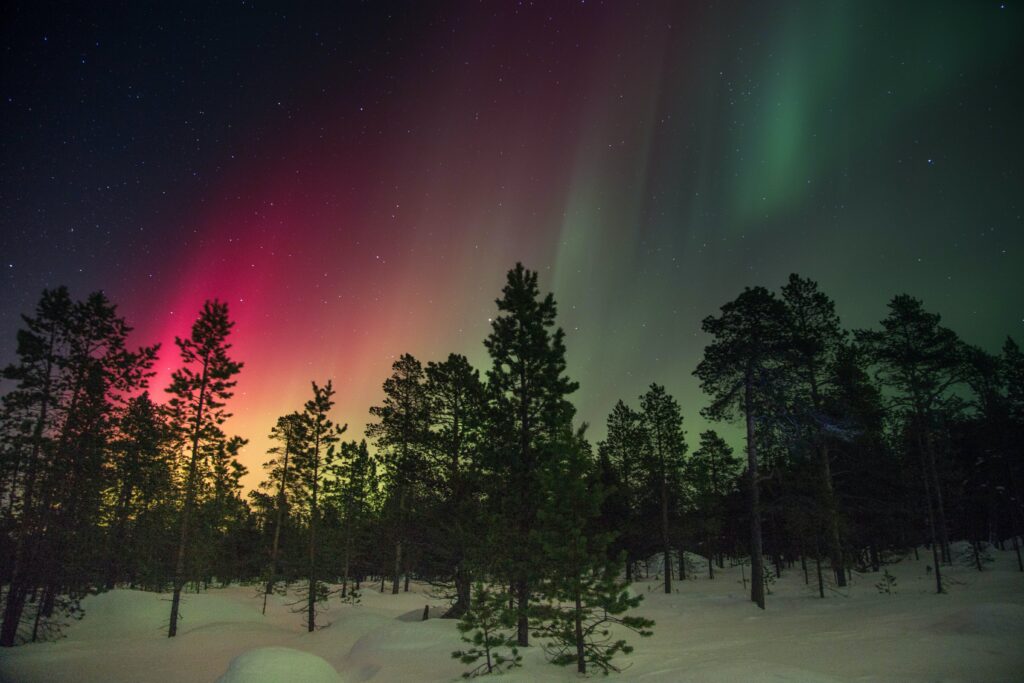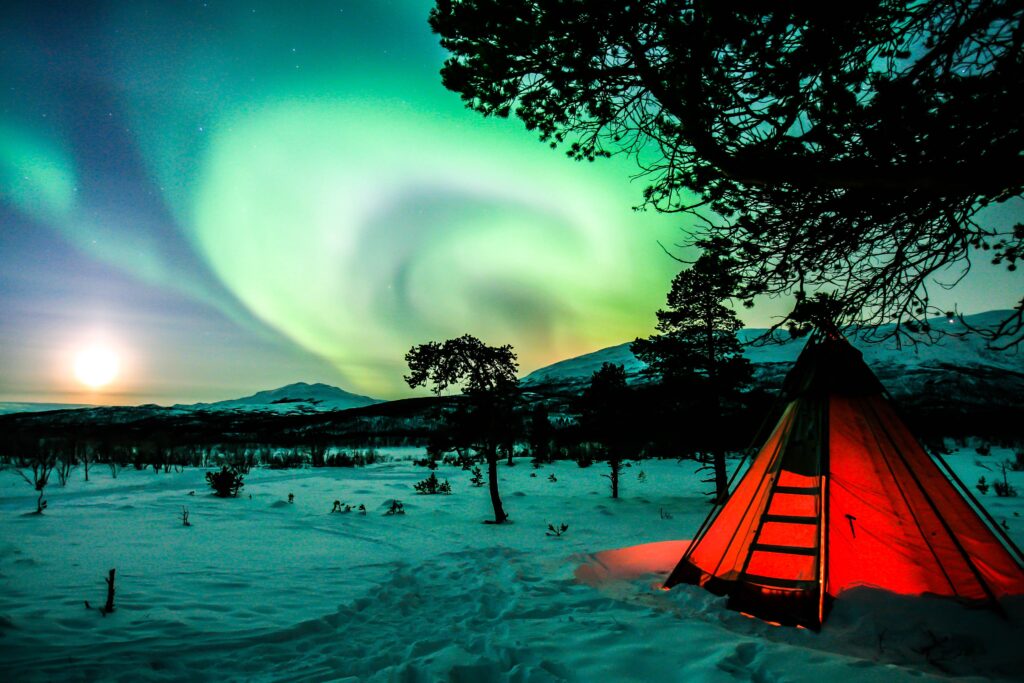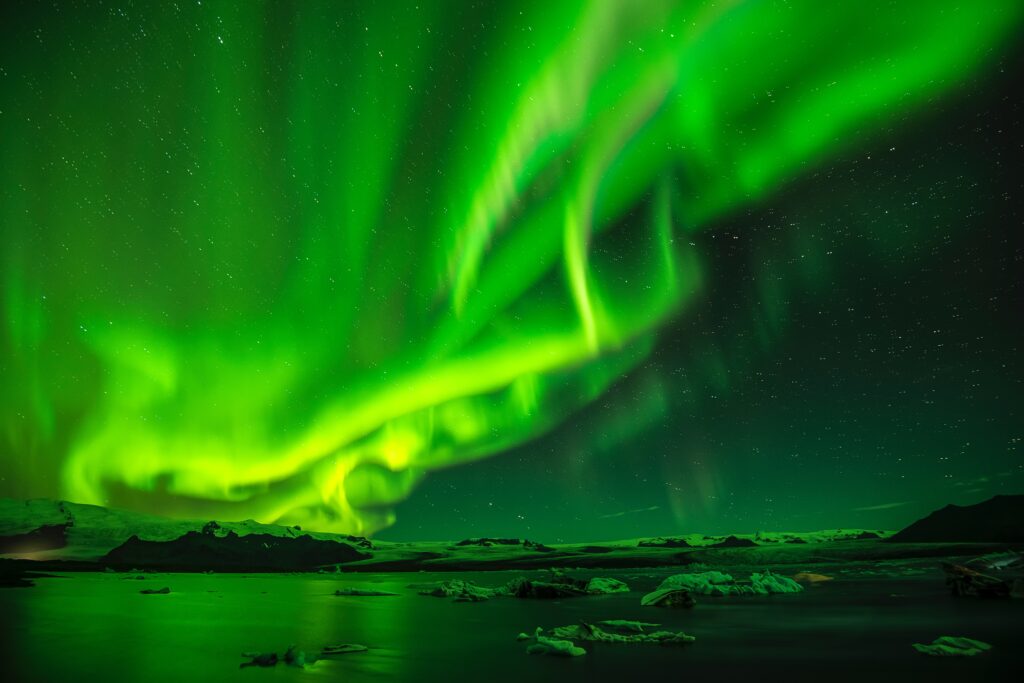The Enchanting Beauty of Iceland’s Northern Lights
Recently updated on January 17, 2025
Total words: 2527

Table Of Content
- The Spectacular Sight of the Northern Lights in Iceland
- The History and Mythology of the Northern Lights
- The Best Time to See the Northern Lights in Iceland
- Tips on Capturing the Northern Lights in Iceland
- The Northern Lights Tours Available in Iceland
Introduction
The Northern Lights – also known as the Aurora Borealis – is one of nature’s most spectacular light shows. Every year, travelers from around the world flock to Iceland to witness this mesmerizing natural phenomenon. Seeing the Northern Lights is an unforgettable experience that will stay with you forever. From its vibrant colors to its captivating movement, there’s no denying that the Northern Lights are truly an enchanting beauty.
The Spectacular Sight of the Northern Lights in Iceland
Iceland is home to some of the world’s greatest natural wonders, and its Northern Lights are among the most spectacular. The Aurora Borealis is a magical event that takes place in the night sky, and its beauty is unparalleled. Every year, thousands of visitors flock to Iceland to witness this amazing phenomenon.
The Aurora Borealis is a result of solar winds interacting with the Earth’s magnetic field. These winds cause charged particles to be released into the atmosphere, creating the amazing colored lights. The lights can appear in hues of green, blue, pink, and even purple and can be seen from September to April.
The best way to experience the Northern Lights is from a dark location away from city lights. If you’re planning a trip to Iceland, try to book your accommodation in an area with less light pollution. You can also take a tour with a Northern Lights expert for the best experience.

The Northern Lights can be unpredictable, so it’s important to be prepared. Make sure to dress in warm layers and bring a headlamp or flashlight. You may also want to bring a tripod and camera to capture the amazing spectacle.
The Northern Lights can be an unforgettable experience, and one that’s truly worth the effort. To increase your chances of seeing the Aurora Borealis, look for forecasts from local meteorologists or use an app like Aurora Forecast.
No matter when you visit Iceland, make sure to keep your eyes peeled for the Northern Lights. With a bit of luck, you can experience the enchanting beauty of this incredible phenomenon.
The History and Mythology of the Northern Lights
The Northern Lights, also known as Aurora Borealis, have captivated people for centuries. They are a natural phenomenon that can be seen in the night sky in the northernmost regions of the world. As far back as the 6th century, they were believed to be the result of a magical energy emanating from the gods. Today, we know that they are a product of charged particles from the sun interacting with the Earth’s atmosphere.
The Science Behind the Northern Lights
The Northern Lights are created when solar wind particles collide with gas molecules in the Earth’s upper atmosphere. This interaction causes the gases to glow, giving off the brilliant colors we observe in the night sky. The colors are determined by the type of gas molecules that are present – oxygen produces yellow and green, while nitrogen produces blue and purple.
Mythology of the Northern Lights
Throughout history, people have attributed various meanings to the Northern Lights. In some cultures, they were seen as a sign of good luck and fortune. In others, they were believed to be the souls of the dead dancing in the night sky. The Inuit people believed that they were the torches of the spirits of their ancestors, guiding them through the darkness of the night.
Observing the Northern Lights in Iceland
Iceland is one of the best places to observe the Northern Lights due to its northern location and lack of light pollution. The best time of year to catch a glimpse of the lights is during the winter months, usually from September to April. Tour companies offer guided tours, providing an opportunity to witness this natural wonder in all its glory.

The Enchantment of the Northern Lights
There is something truly magical about the Northern Lights. From their fascinating history to their stunning beauty, they are a sight to behold. They can be a source of inspiration, a reminder of the beauty of nature, and an awe-inspiring experience that will stay with you forever.
The Best Time to See the Northern Lights in Iceland
The Northern Lights, or Aurora Borealis, is one of the most spectacular natural wonders of the world. With its shimmering colors and dancing ribbons of light, the Northern Lights in Iceland are a sight to behold. But when is the best time to see the Northern Lights in Iceland?
When is the Northern Lights Season in Iceland?
The Northern Lights season in Iceland typically runs from late August to mid-April. During this time, the skies are dark enough for the lights to be visible. The peak viewing times are usually in the winter months, from November to February, when there are longer periods of darkness and the air is usually clearer.
What is the Best Time to See the Northern Lights in Iceland?
The best time to experience the Northern Lights in Iceland is during the winter months, when the sky is clear and the nights are long. Generally, the Northern Lights can be seen starting at 10 PM and lasting until 2 AM. That said, the lights can appear any time between late August and mid-April.
Factors to Consider When Planning a Northern Lights Tour in Iceland
When planning a Northern Lights tour in Iceland, there are a few factors to consider. First, it’s important to check the weather forecast to make sure the sky is clear. Clear, dark skies with no clouds or fog are ideal for viewing the Northern Lights. Second, you should plan your tour for a time when there is little or no moonlight, as the moonlight can interfere with visibility. Finally, it’s best to stay away from light pollution, such as the city lights, as these can also interfere with visibility.
Tips for Viewing the Northern Lights in Iceland
Here are a few tips for viewing the Northern Lights in Iceland. First, dress warmly and bring a thermos of hot tea or coffee. Second, bring a tripod and a camera with manual settings; this will help you capture the lights in all their glory. Third, bring a powerful flashlight, as you may need to use it to adjust your camera settings in the dark. Finally, have patience; the Northern Lights can be unpredictable, so it may take a while to see them.
Tips on Capturing the Northern Lights in Iceland
The Northern Lights in Iceland are an awe-inspiring sight and one of the most beautiful natural phenomena in the world. Photographers of all levels can experience the enchantment of the Aurora Borealis in Iceland, but it takes some preparation and knowledge to capture stunning photographs of the Northern Lights. Here are some tips on capturing Iceland’s Northern Lights that you should keep in mind:
Be Prepared
The most important tip to remember when photographing the Northern Lights is to be prepared. It’s important to research the best time and location for viewing the Aurora Borealis in advance. There are several websites and apps that can help you determine the best time and location for viewing the Northern Lights. Additionally, be sure to dress warmly and wear layers, as temperatures can drop quickly in Iceland.
Choose the Right Camera Gear
Having the right camera gear is essential for capturing the Northern Lights. A DSLR camera with a wide-angle lens is the best option for photographing the Aurora Borealis. A wide-angle lens will allow you to capture more of the sky and the beautiful colors of the Northern Lights. Additionally, a tripod is essential for taking long exposure shots and reducing camera shake.
Use Manual Mode
It’s important to use manual mode when photographing the Northern Lights. Manual mode will allow you to adjust the shutter speed, aperture, and ISO settings for the best results. A slower shutter speed will allow more light into the camera and will create a brighter image. A smaller aperture will help to keep the stars from becoming too bright. And a higher ISO will help to capture more details in the image.
Experiment with Different Settings
Experimenting with different settings is key for capturing beautiful photos of the Northern Lights. Try different shutter speeds, apertures, and ISO settings to find the best combination for the shot you’re trying to capture. Additionally, try to capture the foreground of the image with the Northern Lights in the background. This will create a more interesting image and will help to enhance the beauty of the Aurora Borealis.
Be Patient
The Northern Lights can be unpredictable, so it’s important to be patient when trying to capture the perfect shot. The Aurora Borealis can appear suddenly and then disappear just as quickly, so be sure to take your time and enjoy the experience.

Photographing the Northern Lights in Iceland can be a magical experience, and with a little preparation and patience, you can capture stunning images of the Aurora Borealis. Implementing these tips on capturing Iceland’s Northern Lights will help you to get the best results from your photography session.
The Northern Lights Tours Available in Iceland
Iceland is a unique destination with a vast array of natural wonders to explore. One of the most popular attractions in Iceland is the Northern Lights. The aurora borealis is a spectacular light show that appears in the night sky above Iceland and other northern locations. For visitors to Iceland, experiencing the Northern Lights is a must-do activity. Here, we will explore the various Northern Lights tours available in Iceland.
Tours from Reykjavik
The capital city of Reykjavik is the perfect place to witness the Northern Lights. With its close proximity to the Arctic Circle, the city has some of the best views of the Northern Lights. There are a variety of Northern Lights tours available from Reykjavik. The most popular option is a tour that takes visitors to the Golden Circle and then on to a secluded area to view the lights. This tour typically lasts from eight to twelve hours, and includes stops at Þingvellir National Park, Gullfoss Waterfall, and Geysir Hot Springs.
Tours from Akureyri
Akureyri is another popular destination for those looking to experience the Northern Lights. Located in the north of Iceland, it is slightly further away from the Arctic Circle than Reykjavik but still offers excellent views of the lights. Most Northern Lights tours from Akureyri include transport to a secluded area with minimal light pollution, where visitors can take in the beauty of the lights. Some of these tours also include visits to local attractions such as the Botanical Gardens and the Akureyri Art Museum.
Tours from Husavik
Húsavík is a small fishing village in northern Iceland, known for its picturesque harbor and rich whale-watching opportunities. Though it is further away from the Arctic Circle than Reykjavik and Akureyri, the skies above Húsavík are still perfect for watching the Northern Lights. There are a variety of Northern Lights tours available from Húsavík, ranging from day trips to overnight excursions. Many of these tours include a visit to the Whale Museum, as well as a chance to observe the lights in a secluded area.
Tours from Lake Myvatn
The Lake Mývatn region is a popular destination in northern Iceland, known for its spectacular natural beauty. It is also one of the best places to observe the Northern Lights. This region is home to a variety of Northern Lights tours, which typically involve a visit to the Lake Mývatn Nature Baths, as well as a chance to view the lights in a secluded area. Many of these tours also include visits to nearby attractions such as the Grjótagjá Cave and the Dimmuborgir Lava Fields.
Conclusion
The Northern Lights of Iceland are truly a sight to behold. From the dancing greens and purples to the awe-inspiring reds, the night sky is a canvas of beauty and wonder. Whether you’re a photographer, an adventurer, or just someone who appreciates natural beauty, a trip to Iceland to view the Northern Lights is an experience you won’t soon forget. So don’t wait any longer, book your trip to Iceland today and witness the enchanting beauty of the Northern Lights!
1. What is the best time of year to see the Northern Lights in Iceland?
The best time to see the Northern Lights in Iceland is during the winter months, from September to April. The peak season is typically from late September to late March when the nights are long and dark, providing optimal conditions for viewing the aurora borealis. However, the lights are a natural phenomenon and can be unpredictable, so it’s always best to check the forecast and be prepared to chase them if necessary.
2. Where are the best places in Iceland to see the Northern Lights?
Some of the best places in Iceland to see the Northern Lights include areas with minimal light pollution and clear skies, such as Thingvellir National Park, Landmannalaugar, and the Snaefellsnes Peninsula. These locations offer stunning landscapes as a backdrop to the dancing lights, creating a magical and memorable experience.
3. What causes the Northern Lights to appear in Iceland?
The Northern Lights, also known as aurora borealis, are caused by the interaction between solar wind particles and the Earth’s magnetic field. When charged particles from the sun collide with the Earth’s atmosphere, they create colorful displays of light that can be seen in regions near the magnetic poles, including Iceland.
4. How can I capture the Northern Lights in Iceland with photography?
To capture the beauty of the Northern Lights in Iceland, it’s important to use a DSLR camera with manual settings, a sturdy tripod to avoid camera shake, and a remote shutter release to prevent blurring. Set your camera to a high ISO, wide aperture, and long exposure to capture the vibrant colors and movement of the aurora borealis.
5. Are there guided tours available to see the Northern Lights in Iceland?
Yes, there are numerous guided tours and excursions available in Iceland that specialize in Northern Lights viewing. These tours often take you to prime locations away from city lights, provide expert guides who can explain the phenomenon, and offer amenities like hot drinks and warm shelters to enhance your experience of witnessing the enchanting beauty of the Northern Lights.